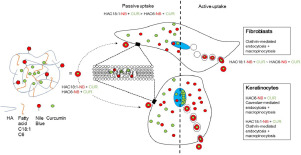当前位置:
X-MOL 学术
›
Eur. J. Pharm. Sci.
›
论文详情
Our official English website, www.x-mol.net, welcomes your
feedback! (Note: you will need to create a separate account there.)
In vitro investigation of hyaluronan-based polymeric micelles for drug delivery into the skin: The internalization pathway.
European Journal of Pharmaceutical Sciences ( IF 4.3 ) Pub Date : 2019-11-26 , DOI: 10.1016/j.ejps.2019.105168 Jana Starigazdová 1 , Kristina Nešporová 1 , Martin Čepa 1 , Romana Šínová 2 , Daniela Šmejkalová 1 , Gloria Huerta-Angeles 1 , Vladimír Velebný 1
European Journal of Pharmaceutical Sciences ( IF 4.3 ) Pub Date : 2019-11-26 , DOI: 10.1016/j.ejps.2019.105168 Jana Starigazdová 1 , Kristina Nešporová 1 , Martin Čepa 1 , Romana Šínová 2 , Daniela Šmejkalová 1 , Gloria Huerta-Angeles 1 , Vladimír Velebný 1
Affiliation

|
In our previous research, we concluded that polymeric micelles based on hyaluronic acid are able to penetrate into the deeper layers of skin tissue. The aim of this work was to characterize the mechanisms involved in the uptake by skin cells, which is important for understanding the influence of the carrier composition on the drug penetration. To reach this goal, we used micelles encapsulating curcumin made of oleyl-hyaluronan (HAC18:1) and hexyl-hyaluronan (HAC6) covalently linked with fluorescent Nile Blue. This labeling enabled us to track the micelle-forming derivative and also micelle payload into the keratinocytes and fibroblasts by fluorescent microscopy and flow cytometry. The regulation of both the passive and active cellular uptake was used to determine the mechanism of micelle internalization. Furthermore, the changes of membrane fluidity were measured for these derivatives by FRAP. Using these methods we concluded that carriers entered the cells using both active and passive transport. Passive transport was facilitated by the affinity of the carrier to the cell membrane, especially in the case of HAC18:1 carrier, which changed significantly the membrane fluidity. The active transport was dependent on cell type, but mainly driven by the clathrin-mediated endocytosis and macropinocytosis. Surprisingly, the main HA receptor, CD44, was not involved in the uptake. We can conclude that these carrier systems could be used for the local transport of active substances or hydrophobic drugs into the skin cells using the advantage of passive transport of oleyl-HA derivative.
中文翻译:

透明质酸基聚合物胶束体外药物递送到皮肤的研究:内在化途径。
在我们先前的研究中,我们得出结论,基于透明质酸的聚合物胶束能够渗透到皮肤组织的更深层。这项工作的目的是表征皮肤细胞摄取所涉及的机制,这对于理解载体组合物对药物渗透的影响非常重要。为了达到这个目标,我们使用了胶束,封装了由油酰-透明质酸(HAC18:1)和己基-透明质酸(HAC6)与荧光尼罗河蓝共价连接的姜黄素。这种标记使我们能够通过荧光显微镜和流式细胞术追踪形成胶束的衍生物,以及进入胶质细胞和成纤维细胞的胶束有效载荷。被动和主动细胞摄取的调节被用来确定胶束内在化的机制。此外,用FRAP测定这些衍生物的膜流动性变化。使用这些方法,我们得出结论,携带者通过主动和被动运输进入细胞。载体与细胞膜的亲和性促进了被动转运,尤其是在HAC18:1载体的情况下,后者显着改变了膜的流动性。主动转运取决于细胞类型,但主要由网格蛋白介导的内吞作用和巨胞饮作用所驱动。令人惊讶的是,主要的HA受体CD44没有参与摄取。我们可以得出结论,利用油基-HA衍生物的被动转运优势,这些载体系统可用于将活性物质或疏水性药物局部转运到皮肤细胞中。使用这些方法,我们得出结论,携带者通过主动和被动运输进入细胞。载体与细胞膜的亲和力促进了被动转运,尤其是在HAC18:1载体的情况下,后者显着改变了膜的流动性。主动转运取决于细胞类型,但主要由网格蛋白介导的内吞作用和巨胞饮作用所驱动。令人惊讶的是,主要的HA受体CD44没有参与摄取。我们可以得出结论,利用油基-HA衍生物的被动转运优势,这些载体系统可用于将活性物质或疏水性药物局部转运到皮肤细胞中。使用这些方法,我们得出结论,携带者通过主动和被动运输进入细胞。载体与细胞膜的亲和性促进了被动转运,尤其是在HAC18:1载体的情况下,后者显着改变了膜的流动性。主动转运取决于细胞类型,但主要由网格蛋白介导的内吞作用和巨胞饮作用所驱动。令人惊讶的是,主要的HA受体CD44没有参与摄取。我们可以得出结论,利用油基-HA衍生物的被动转运优势,这些载体系统可用于将活性物质或疏水性药物局部转运到皮肤细胞中。特别是在HAC18:1载体的情况下,它显着改变了膜的流动性。主动转运取决于细胞类型,但主要由网格蛋白介导的内吞作用和巨胞饮作用所驱动。令人惊讶的是,主要的HA受体CD44没有参与摄取。我们可以得出结论,利用油基-HA衍生物的被动转运优势,这些载体系统可用于将活性物质或疏水性药物局部转运到皮肤细胞中。特别是在HAC18:1载体的情况下,它显着改变了膜的流动性。主动转运取决于细胞类型,但主要由网格蛋白介导的内吞作用和巨胞饮作用所驱动。令人惊讶的是,主要的HA受体CD44没有参与摄取。我们可以得出结论,利用油基-HA衍生物的被动转运优势,这些载体系统可用于将活性物质或疏水性药物局部转运至皮肤细胞。
更新日期:2019-11-27
中文翻译:

透明质酸基聚合物胶束体外药物递送到皮肤的研究:内在化途径。
在我们先前的研究中,我们得出结论,基于透明质酸的聚合物胶束能够渗透到皮肤组织的更深层。这项工作的目的是表征皮肤细胞摄取所涉及的机制,这对于理解载体组合物对药物渗透的影响非常重要。为了达到这个目标,我们使用了胶束,封装了由油酰-透明质酸(HAC18:1)和己基-透明质酸(HAC6)与荧光尼罗河蓝共价连接的姜黄素。这种标记使我们能够通过荧光显微镜和流式细胞术追踪形成胶束的衍生物,以及进入胶质细胞和成纤维细胞的胶束有效载荷。被动和主动细胞摄取的调节被用来确定胶束内在化的机制。此外,用FRAP测定这些衍生物的膜流动性变化。使用这些方法,我们得出结论,携带者通过主动和被动运输进入细胞。载体与细胞膜的亲和性促进了被动转运,尤其是在HAC18:1载体的情况下,后者显着改变了膜的流动性。主动转运取决于细胞类型,但主要由网格蛋白介导的内吞作用和巨胞饮作用所驱动。令人惊讶的是,主要的HA受体CD44没有参与摄取。我们可以得出结论,利用油基-HA衍生物的被动转运优势,这些载体系统可用于将活性物质或疏水性药物局部转运到皮肤细胞中。使用这些方法,我们得出结论,携带者通过主动和被动运输进入细胞。载体与细胞膜的亲和力促进了被动转运,尤其是在HAC18:1载体的情况下,后者显着改变了膜的流动性。主动转运取决于细胞类型,但主要由网格蛋白介导的内吞作用和巨胞饮作用所驱动。令人惊讶的是,主要的HA受体CD44没有参与摄取。我们可以得出结论,利用油基-HA衍生物的被动转运优势,这些载体系统可用于将活性物质或疏水性药物局部转运到皮肤细胞中。使用这些方法,我们得出结论,携带者通过主动和被动运输进入细胞。载体与细胞膜的亲和性促进了被动转运,尤其是在HAC18:1载体的情况下,后者显着改变了膜的流动性。主动转运取决于细胞类型,但主要由网格蛋白介导的内吞作用和巨胞饮作用所驱动。令人惊讶的是,主要的HA受体CD44没有参与摄取。我们可以得出结论,利用油基-HA衍生物的被动转运优势,这些载体系统可用于将活性物质或疏水性药物局部转运到皮肤细胞中。特别是在HAC18:1载体的情况下,它显着改变了膜的流动性。主动转运取决于细胞类型,但主要由网格蛋白介导的内吞作用和巨胞饮作用所驱动。令人惊讶的是,主要的HA受体CD44没有参与摄取。我们可以得出结论,利用油基-HA衍生物的被动转运优势,这些载体系统可用于将活性物质或疏水性药物局部转运到皮肤细胞中。特别是在HAC18:1载体的情况下,它显着改变了膜的流动性。主动转运取决于细胞类型,但主要由网格蛋白介导的内吞作用和巨胞饮作用所驱动。令人惊讶的是,主要的HA受体CD44没有参与摄取。我们可以得出结论,利用油基-HA衍生物的被动转运优势,这些载体系统可用于将活性物质或疏水性药物局部转运至皮肤细胞。











































 京公网安备 11010802027423号
京公网安备 11010802027423号